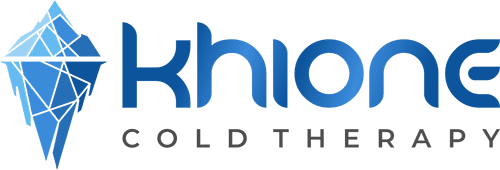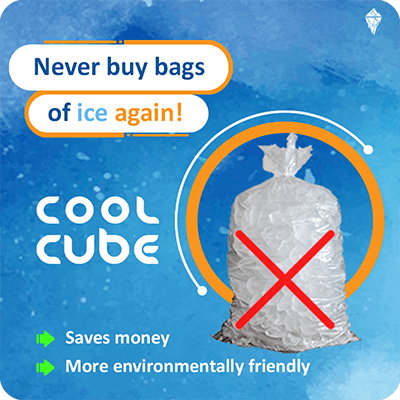
Powerful Coolers
No more ice needed
Easy installment
Any bath/tub/pool will work
How to Boost Athletic performance with Cold Therapy
April 24, 2024


Discover the transformative power of cold plunge therapy—a tool that not only speeds recovery but can also significantly enhance athletic performance when used strategically before competition. This innovative approach to physical conditioning leverages the chilling effects of ice baths to improve mental fortitude and metabolic
functions, making it a critical component of many top athletes’ training routines.
Enhanced Performance through Cold Exposure
Research has shown that pre-cooling the body can lead to remarkable improvements in exercise performance. Studies conducted by Stanford University’s Craig Heller, PhD, and Dennis Grahn, PhD, have uncovered that cooling the body prior to physical exertion can increase work output by up to 40% in bench presses and an astounding 144% in pull-ups (Grahn et al. 2005, Grahn et al. 2012). These findings underscore the potential of thermal regulation to significantly boost both athletic and cognitive performance, suggesting that mastering one’s internal temperature controls could be one of the most effective ways to enhance physical capabilities.
The Science Behind Cold Plunge Benefits
Cold exposure isn’t just for recovery. When used before exercising, it has been proven to facilitate quicker rehabilitation than traditional post-workout ice baths. Intriguingly, the speed of skin temperature recovery post-exercise correlates with superior cardiovascular fitness, as shown in studies involving athletes across various disciplines from running to cycling (Jastrzebska et al. 2022; Spannagl et al. 2023; Fenemor et al. 2022).
Yet, the application of ice baths in training regimes remains largely unexplored systematically. However, anecdotal evidence and isolated studies suggest significant potential benefits. For instance, the San Francisco 49’ers incorporated cold therapy into their training, illustrating the practical application of these findings in high-stakes environments such as the Super Bowl.
Mental and Metabolic Advantages
The mental grit required for high-level competition can be cultivated through disciplined cold exposure. David Goggins, known for his extreme athletic pursuits, exemplifies the potential mental benefits. Studies suggest that regions of the brain involved in resilience, such as the anterior midcingulate cortex, are enhanced through challenging activities like cold immersion (Huberman, 2021).
Furthermore, the metabolic impact of cold immersion includes mitochondrial enhancement and stimulation of endogenous ketone production, which are crucial for energy conversion and efficient mechanical work during physical activities. The interplay between cold exposure and mitochondrial activity helps in adapting to intense
exercises and could potentially support higher endurance and power during athletic performances.
Conclusion
Integrating cold plunge therapy into athletic training isn’t just about recovery—it’s a multifaceted enhancement strategy that prepares the body and mind for peak performance. Whether it’s building mental toughness or boosting metabolic function, the benefits of a calculated dip into icy waters before a competition are too significant to overlook. As research continues to evolve, the full scope of cold plunge benefits on athletic performance will become clearer, potentially setting new standards for sports training regimens.
Creating Your Cold Therapy Sanctuary with Khione
April 9, 2024
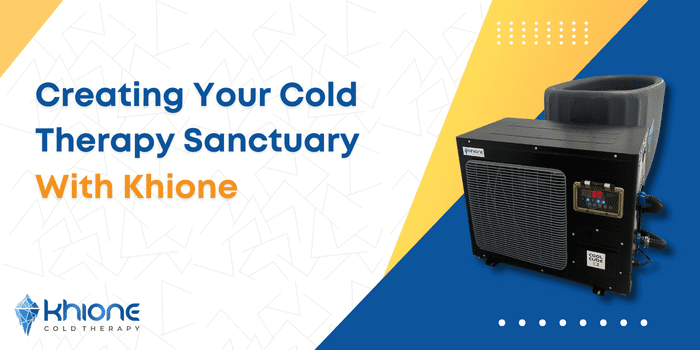

Recovering from a tough workout or simply seeking a refreshing way to unwind? Look no further than creating your cold therapy sanctuary at home with Khione! Cold therapy, particularly through ice baths, has become increasingly popular for its potential benefits like reducing muscle soreness, and inflammation and improving overall recovery.
The key to unlocking the power of cold therapy lies in personalisation. Khione offers a range of high-quality products designed to help you create a cold therapy experience tailored to your specific needs and preferences. In this blog, we’ll guide you through Khione’s cold therapy solutions, helping you transform a designated space into your haven of rejuvenation.
The Khione Cold Therapy Sanctuary Essentials:
- CoolCube C2 with Filter Pump:
The CoolCube C2 with Filter Pump is the centrepiece of your cold therapy sanctuary. This innovative water chiller allows you to customize your cold bath experience with precision. Here’s how it works:
Precise Temperature Control: Fill your bath with water and connect the CoolCube C2. The intuitive control panel lets you set your desired temperature, ensuring a consistent and comfortable cold soak.
Powerful Cooling: The CoolCube C2 packs a punch with its efficient cooling system. It can rapidly chill your bathwater to your preferred temperature, allowing you to start your recovery session quickly.
Enhanced Hygiene: The integrated filter pump ensures clean and refreshing water throughout your ice bath. This eliminates the need for constant water changes, making your cold therapy routine more convenient.
- CoolTub Localized Cold Therapy:
While full immersion ice baths offer numerous benefits, Khione understands that targeted cold therapy might be preferable for specific needs. This is where the CoolTub range comes in. CoolTub is rock hard and sturdy, giving it that distinct high-quality look and feel.

Here are some of the advantages of CoolTubs:
Portable and Convenient: Forget bulky ice packs! CoolTubs are lightweight and ultra-durable, thanks to the latest materials and techniques. They come with a handy backpack for easy carrying and transport, allowing you to enjoy cold therapy anywhere, anytime.
Enhanced Efficiency with CoolCube: Pair your CoolTub with a CoolCube C2 for an unbeatable cold therapy experience. The CoolTub’s design optimizes water temperature maintenance, maximizing the efficiency of the CoolCube’s cooling power.
Versatility: Enjoy the flexibility of using your CoolTub with or without the CoolCube. Whether you prefer a full cold therapy routine with the CoolCube or a standalone localized treatment, the CoolTub caters to your needs.
Rock-Solid Construction: Once inflated, the CoolTub becomes firm and sturdy, providing a secure and comfortable cold therapy experience. The high-quality materials ensure it looks and feels premium.
Building Your Sanctuary:
Now that you’re familiar with Khione’s key cold therapy products, let’s explore how to create your ideal cold therapy sanctuary:
- Finding the Perfect Space: Choose a quiet and well-ventilated area in your home. Ideally, it should be a space where you can relax and focus on your recovery.
- Setting the Mood: Create a calming atmosphere. Dim the lights, light some aromatherapy candles, or play some soothing music to enhance your relaxation experience.
- Preparation is Key: Before starting your cold therapy session, have everything you need within reach. This could include towels, a bathrobe, a water bottle, and your favourite book or music player.
Khione Cold Therapy Tips:
- Listen to Your Body: Start slow, especially with ice baths. Begin with shorter durations (3-5 minutes) and gradually increase the time as your tolerance improves. It’s crucial to pay attention to your body’s signals and stop if you experience any discomfort.
- Hydration is Key: Drink plenty of fluids before, during, and after your cold therapy session to stay hydrated.
- Warm Up Afterwards: Don’t jump straight into a hot shower after your cold therapy. Gradually increase your core body temperature with light activity or warm towels.
Khione: Your Partner in Cold Therapy
Khione is dedicated to providing you with the tools and knowledge you need to experience the potential benefits of cold therapy. With the CoolCube Series and CoolTub, you can create a personalized cold therapy routine in the comfort of your own home. Remember, consistency is key! Regular cold therapy sessions, tailored to your needs, can be a valuable tool in your recovery routine, helping you feel your best and reach your fitness goals.
Disclaimer:
While cold therapy offers numerous potential benefits, it’s important to consult with your Cold Therapy Expert before starting any new recovery routine, especially if you have any pre-existing health conditions.
Khione CoolCube Series Comparison
March 26, 2024
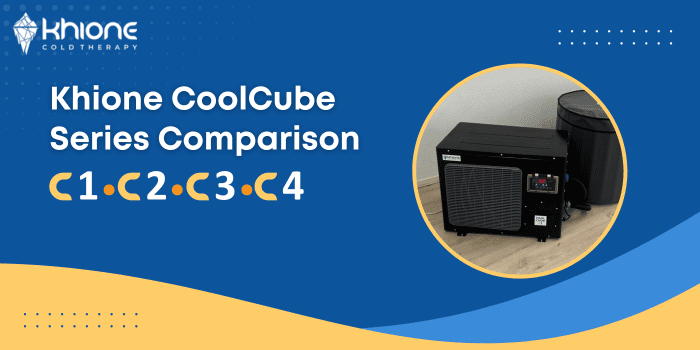

Introduction
Choosing the right cooler for your needs can significantly enhance your cold therapy experience. Khione offers a range of CoolCube coolers, each designed to meet different requirements, from personal use to professional settings. This guide aims to help you compare our models and make an informed decision.
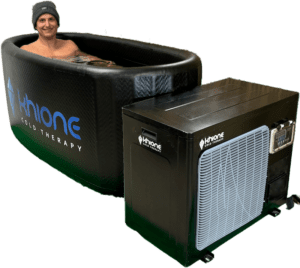

CoolCube Models Overview
CoolCube C1
- Ideal for: Personal use, small tubs.
- Capacity: Up to 250 liters.
- Features: Compact design, energy-efficient, quick cooling.
- Weight: Light, easy to move without wheels.
CoolCube C2
- Ideal for: Medium-sized setups, frequent use.
- Capacity: Up to 1000 liters.
- Features: Enhanced cooling power, supports moderate volumes, optional heating function.
- Weight: Moderate, manageable for regular adjustments.
CoolCube C3
- Ideal for: Professional use, large tubs.
- Capacity: Up to 2500 liters.
- Features: Powerful cooling and heating up to 35°C, robust build.
- Weight: 42 kg, stationary setup recommended.
- Sanitization: Compatible with external pump sets featuring built-in sanitization.
CoolCube C4
- Ideal for: Commercial use, multiple tubs.
- Capacity: Largest capacity exceeding 2500 liters.
- Features: Maximum cooling efficiency, suitable for back-to-back use, advanced temperature control.
- Weight: Heavy, designed for permanent installations.
Making Your Choice
When selecting a CoolCube cooler, consider the following:
- Volume Needs: Match the cooler’s capacity with your tub’s size.
- Mobility: Smaller models are easier to move if needed.
- Heating Requirements: If you also need heating, choose models with dual functionality.
- Usage Frequency: Professional and commercial models are built for frequent, intensive use.
Conclusion
Whether you’re a cold therapy enthusiast or a professional spa owner, there’s a CoolCube model tailored to your needs. Review the features, capacity, and intended use to find your perfect match.
For more detailed specifications or to purchase, visit www.khione.store.
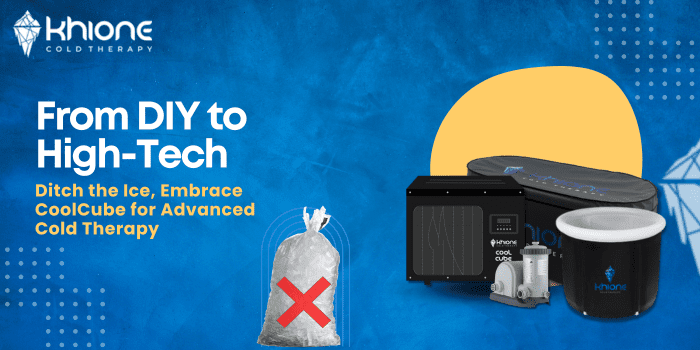

The Rise of Cold Therapy and its Icy Limitations:
Cold therapy has emerged as a popular tool for athletes, fitness enthusiasts, and individuals seeking natural pain management and recovery. Immersing oneself in icy water, commonly known as cold water immersion (CWI) or an ice bath, offers a range of purported benefits. Studies suggest it can:
- Reduce muscle soreness and inflammation: Following intense exercise, microscopic tears occur in muscle fibers. Cold therapy is believed to constrict blood vessels, reducing inflammation and promoting faster healing.
- Improve sleep quality: The drop in core body temperature post-immersion can trigger the release of sleep-promoting hormones.
- Enhance mood and well-being: Cold exposure can activate the sympathetic nervous system, leading to increased alertness and improved cognitive function.
While the potential advantages of cold therapy are promising, traditional methods using ice baths come with inherent drawbacks:
- Messy and Inconvenient: Filling a bathtub with ice requires significant preparation, time, and effort. Melting ice can also create a slippery and potentially hazardous environment.
- Inconsistent Temperature Control: Maintaining a desired water temperature throughout the immersion period is challenging with melting ice. Fluctuations can impact the effectiveness of the treatment.
- Limited Accessibility: Not everyone has access to a bathtub suitable for cold therapy, and the process can be physically demanding for individuals with mobility limitations.
Introducing CoolCube: A Technological Leap in Cold Therapy
The CoolCube water chiller significantly advances cold therapy, offering a convenient, efficient, and personalized approach. This innovative technology functions as a closed-loop water chiller that connects directly to your existing bathtub or pool. Here’s how it works:
- Targeted Cooling: CoolCube utilizes advanced cooling technology to precisely cool the circulating water within the tub or pool to your desired temperature.
- Continuous Circulation: A built-in pump ensures consistent water flow, maintaining a uniform temperature throughout the immersion.
- Energy Efficiency: CoolCube operates efficiently, consuming minimal power compared to traditional methods that rely solely on ice.
Benefits of CoolCube over Traditional Ice Baths:
- Unmatched Convenience: Eliminate the hassle of purchasing, transporting, and handling large quantities of ice.
- Precise Temperature Control: Set your desired temperature and enjoy a consistent, therapeutic experience.
- Faster Cooling Times: CoolCube rapidly cools the water, allowing you to begin your cold therapy session quickly (0°C in less than 30 minutes).
- Reduced Maintenance: No need for constant monitoring or refilling with ice.
- Environmentally Friendly: CoolCube’s closed-loop system minimizes water waste compared to traditional methods.
The Khione CoolTub Pack: A Complete Cold Therapy Solution
Khione offers the CoolTub Pack, a comprehensive package designed to elevate your cold therapy experience. This premium set includes:
- A CoolCube chiller: Choose from various models (C1, C2, C3, and C4) with varying cooling capacities to suit your needs (tub size, desired cooling rate).
- Submersible pump: Ensures efficient water circulation and maintains consistent temperature throughout the immersion.
- Insulated hoses: Minimize heat transfer for optimal cooling performance.
- Optional accessories: Khione offers additional accessories like thermometers and water purification systems to enhance your cold therapy experience.
CoolCube: Tailored for Diverse Needs:
The versatility of the CoolCube system caters to a broad spectrum of individuals:
- Athletes: Experience faster recovery times, reduced muscle soreness and inflammation, and potentially improved athletic performance.
- Fitness Enthusiasts: Alleviate muscle fatigue after workouts and potentially enhance overall well-being.
- Pain Management: Cold therapy can offer temporary relief from chronic pain conditions like arthritis and muscle spasms.
- General Wellness: Immersion in cold water can promote relaxation, improve sleep quality, and potentially boost mood.
Safety Considerations and Consulting a Healthcare Professional:
While cold therapy offers numerous benefits, it’s crucial to prioritize safety. Here are some essential points to remember:
- Gradual Immersion: Begin with shorter immersion times and gradually increase the duration as tolerated.
- Listen to Your Body: Discontinue the session if you experience any discomfort, such as numbness, tingling, or dizziness.
- Consult a Healthcare Professional: Individuals with pre-existing medical conditions, pregnant women, and those taking certain medications should consult a healthcare professional before starting cold therapy.
Conclusion: Embrace the Future of Cold Therapy with CoolCube:
The CoolCube system represents a significant advancement in cold therapy, offering a convenient, effective, and personalized solution. By eliminating the limitations of traditional ice baths, CoolCube allows you to unleash the full potential of cold therapy and experience its transformative benefits in a convenient, consistent, and personalized manner.
Ice Baths: Different Doses for Different Folks
March 4, 2024
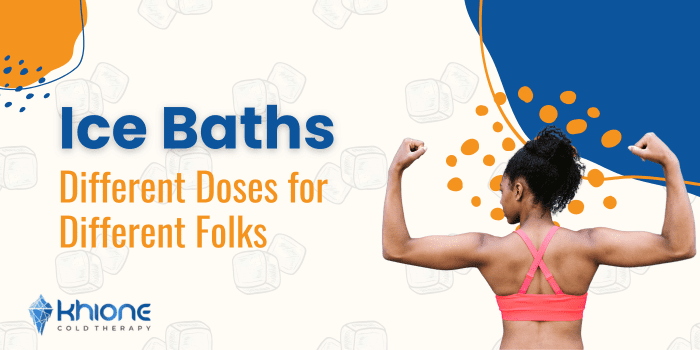

Ice baths have become a popular recovery method for athletes and fitness enthusiasts alike. While the potential benefits, like reduced muscle soreness and inflammation, are enticing, it’s crucial to remember that one size doesn’t fit all when it comes to this practice.
Just like your workout routine is personalized to your fitness level, your ice bath approach should be too. This blog delves into why and how to tailor your ice bath “dose” based on your individual needs.
Why Individualize Your Ice Bath?
The human body is incredibly adaptable, but its capacity for handling cold exposure varies greatly. Factors like age, overall health, and fitness level all play a role in how well you tolerate an ice bath.
For beginners, starting too aggressively can be counterproductive, leading to discomfort, increased stress, and even potential injury. On the other hand, experienced athletes might require longer durations or colder temperatures to achieve the desired benefits.
So, how do you find your sweet spot?
Here are some key factors to consider:
- Fitness Level:
- Beginners: Start with shorter durations (3-5 minutes) and warmer water (around 10°C – 15°C). CoolCube water chillers offer a more gradual and manageable cold therapy option.
- Intermediate: As you adapt, gradually increase the duration (5-10 minutes) and decrease the water temperature (7°C – 10°C) if desired.
- Advanced: Experienced athletes can explore longer durations (10-15 minutes) and even colder water temperatures (below 7°C), but exercise caution and listen to your body.
- Health:
- Consult your doctor before starting ice baths if you have any pre-existing health conditions, especially cardiovascular issues, circulatory problems, or uncontrolled high blood pressure.
- Personal Tolerance:
- Start slow and pay close attention to your body’s signals. If you experience intense shivering, dizziness, or pain, end the ice bath immediately. Remember, it’s not a competition; do what feels right for you.
Beyond the Basics:
While the above points offer a general framework, remember that everyone is unique. Here are some additional tips for optimizing your ice bath experience:
- Before Warm Up: Light activities like walking or jogging can help prepare your body for the cold shock.
- Focus on deep breathing: Slow, controlled breaths can help manage discomfort and promote relaxation.
- Listen to your body: Don’t push yourself beyond your limits. If you feel unwell, get out of the ice bath and seek warmth.
- Gradually re-warm: After the ice bath, gradually increase your core body temperature with light activity or warm towels.
- Hydrate: Drink plenty of fluids before, during, and after your ice bath to stay hydrated.
Cold Therapy Solutions:
For individuals looking for alternative and potentially less intense approaches to cold therapy, products like CoolCube water chillers and CoolTub localized cold wraps can be suitable options. CoolCube chillers offer a controlled and customisable experience, allowing you to cool your bathwater to your desired temperature and target specific areas of your body that might be sore or inflamed. They are available in different models to fit your needs, making them a great option for athletes, fitness enthusiasts, and anyone seeking the benefits of cold therapy.
Remember, consistency is key! Regular ice baths, tailored to your needs, can be a valuable tool in your recovery routine, helping you bounce back from workouts faster and feel your best. Always prioritize safety and listen to your body to achieve optimal results.
From Athlete to Weekend Warrior: Applications of Cold Therapy
February 22, 2024
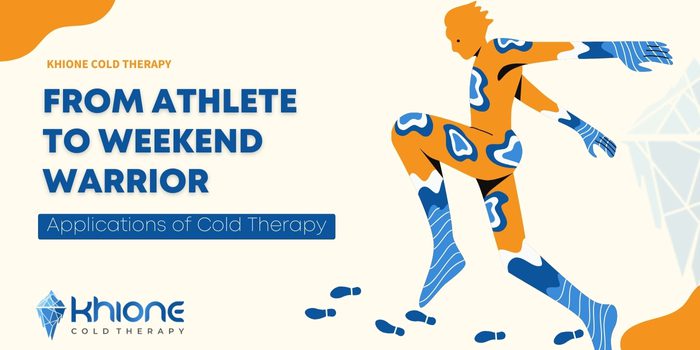

Athletes and weekend warriors confront various problems in their physical activity, particularly in terms of injury and recuperation. Understanding the subtleties of cold treatment can help you maximize performance while avoiding pain. Below is a discussion of how each group can benefit from this therapy method.
Athletes:
Athletes have rigorous and frequent training sessions, which increases their risk of acute injuries including sprains and strains. As a result, people frequently opt for cold therapy quickly after an injury occurs. This method serves a variety of purposes:
- Reduce swelling and inflammation: Cold constricts blood vessels, reducing fluid accumulation and tissue damage at the injury site.
- Numb pain: The cold inhibits pain signals, providing brief respite and allowing athletes to better control discomfort.
- Reduce muscle damage: Cold therapy may reduce tissue breakdown by lowering cellular metabolism, which aids in recuperation.
Weekend Warriors:
Weekend warriors may engage in less intense and frequent physical activities, but they are nonetheless at risk of pain, particularly delayed onset muscle soreness (DOMS). Cold therapy can help them in the following ways:
Post-workout recovery: Cold therapy after exercise helps alleviate muscular pain and DOMS by reducing inflammation and preventing muscle fibre damage.
Preventative measures: After extremely intensive activity, cold therapy can be used to address potential pain and promote faster recovery.
Key differences:
The fundamental difference in cold therapy utilization is in its intent and timing.
- Athletes prioritize acute injuries, using cold therapy for pain relief and tissue protection as soon as possible after an occurrence.
- Weekend warriors focus on preventing and controlling muscular soreness by using cold therapy after workouts or intense activities.
Additional considerations:
Cold therapy options include ice baths for athletes and ice packs or compression wraps for weekend warriors. The duration of cold therapy application varies according to individual demands and conditions.
Understanding the targeted application of cold therapy allows both athletes and weekend warriors to properly support their bodies in achieving peak performance and recuperation.
Enhance your recovery with Khione Cold Therapy.
We offer ice bath products designed for both elite athletes and fitness enthusiasts. Our innovative technology makes cold therapy convenient and accessible, helping you achieve optimal performance and well-being.
Contact us today to learn more about the benefits of Khione Cold Therapy and join our community of #KhioneWarriors.
Stay safe and recover faster.
